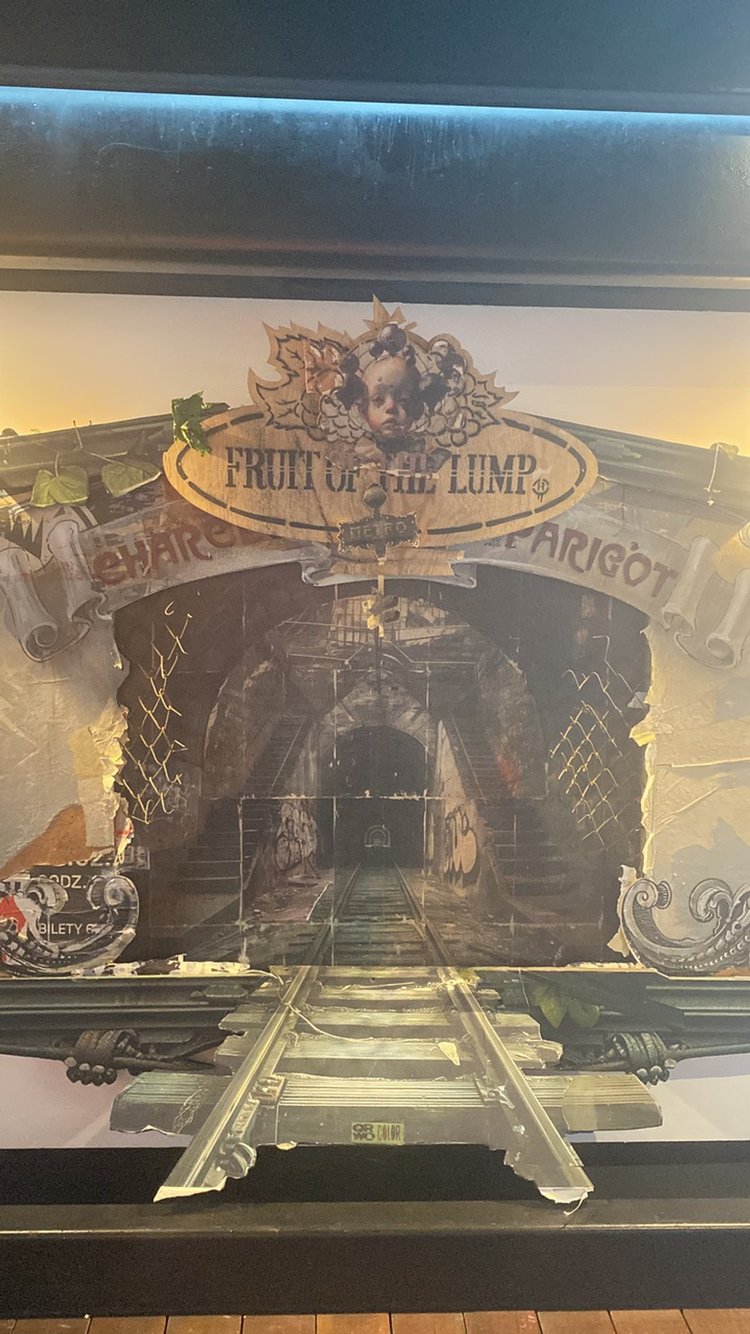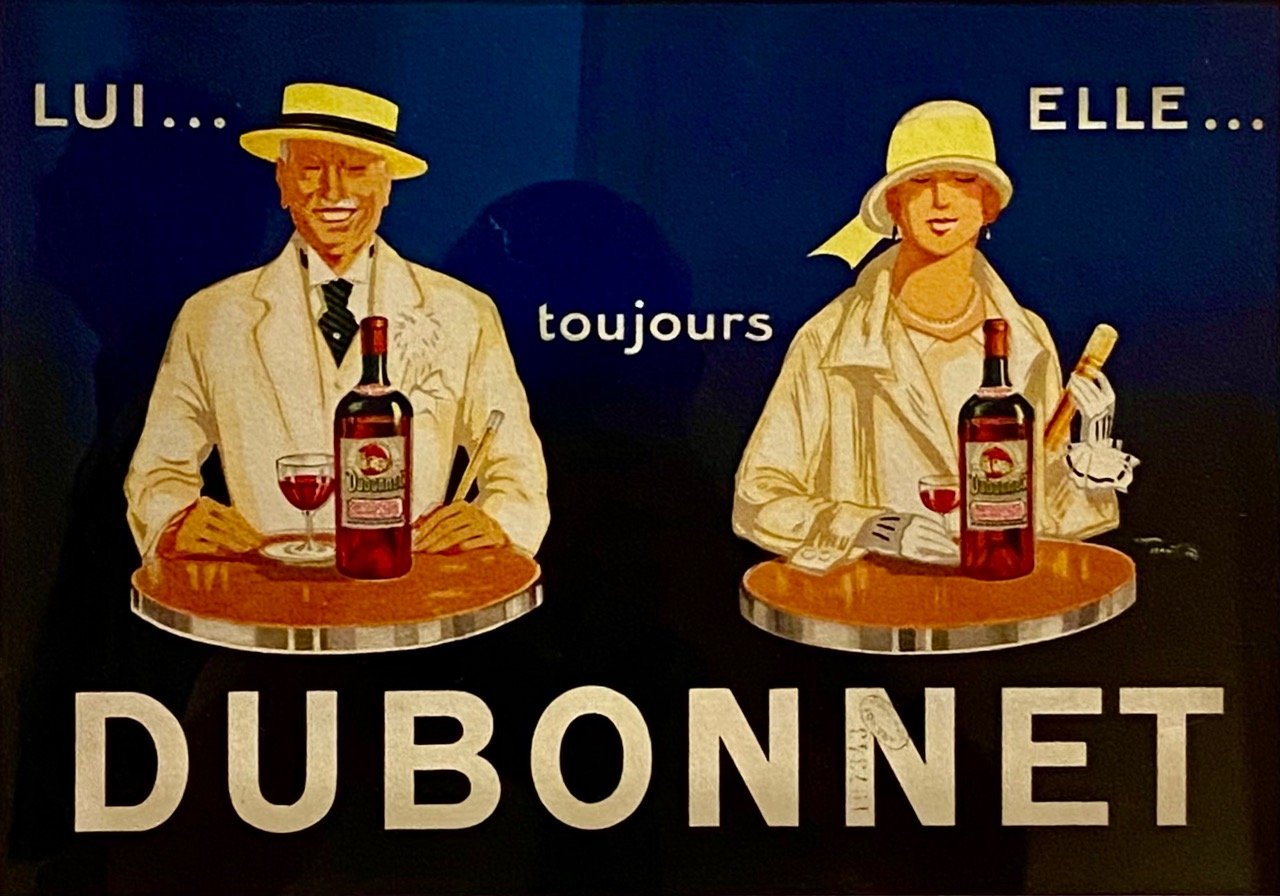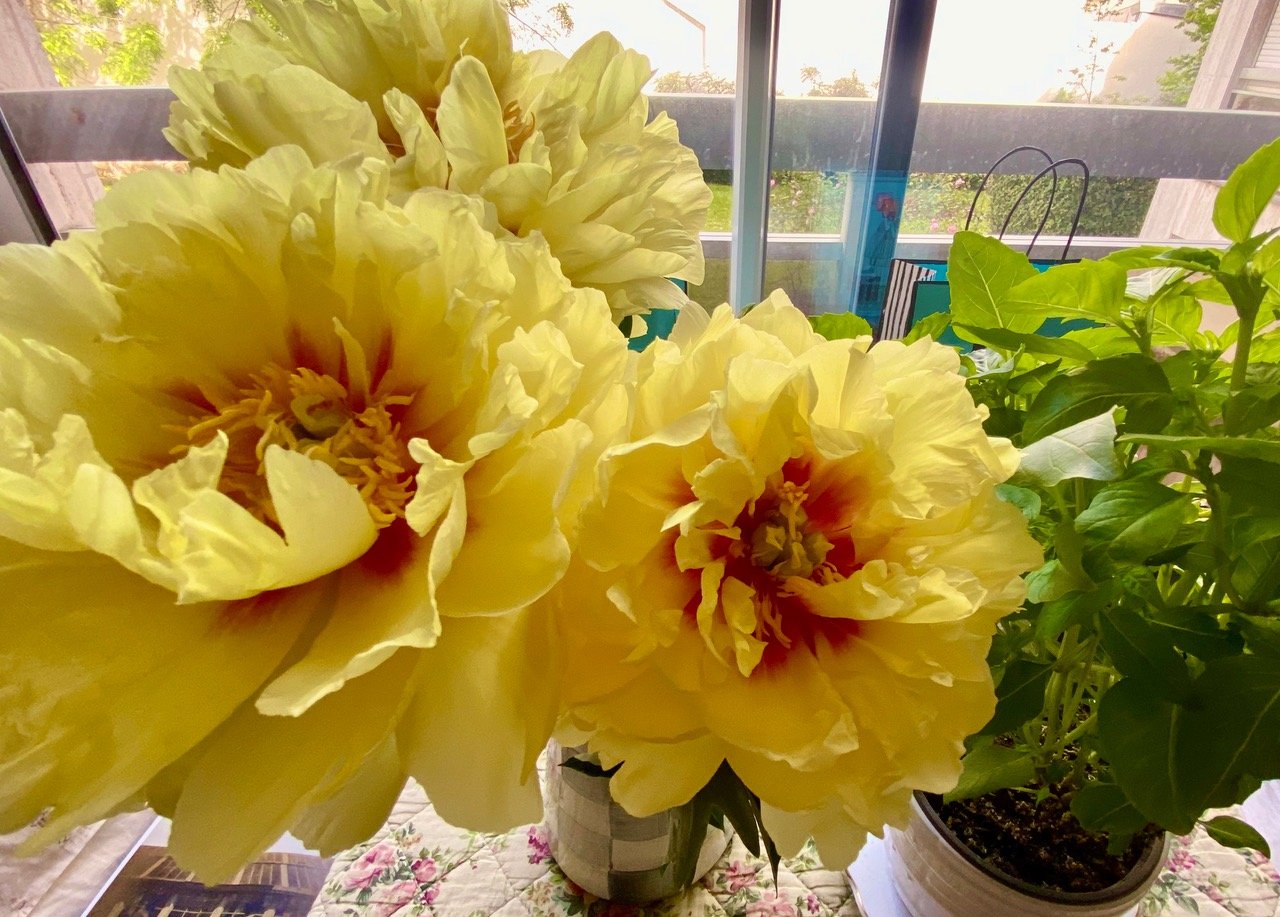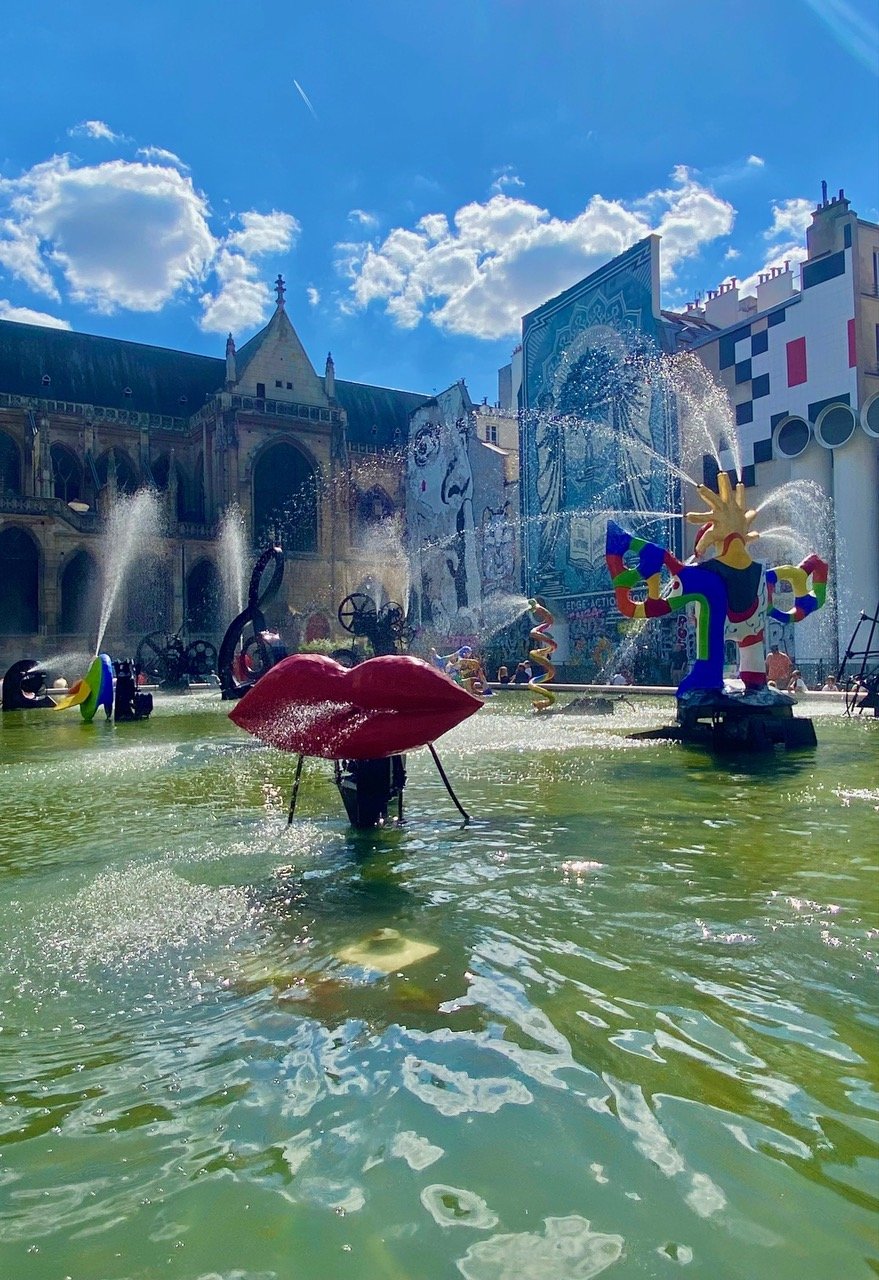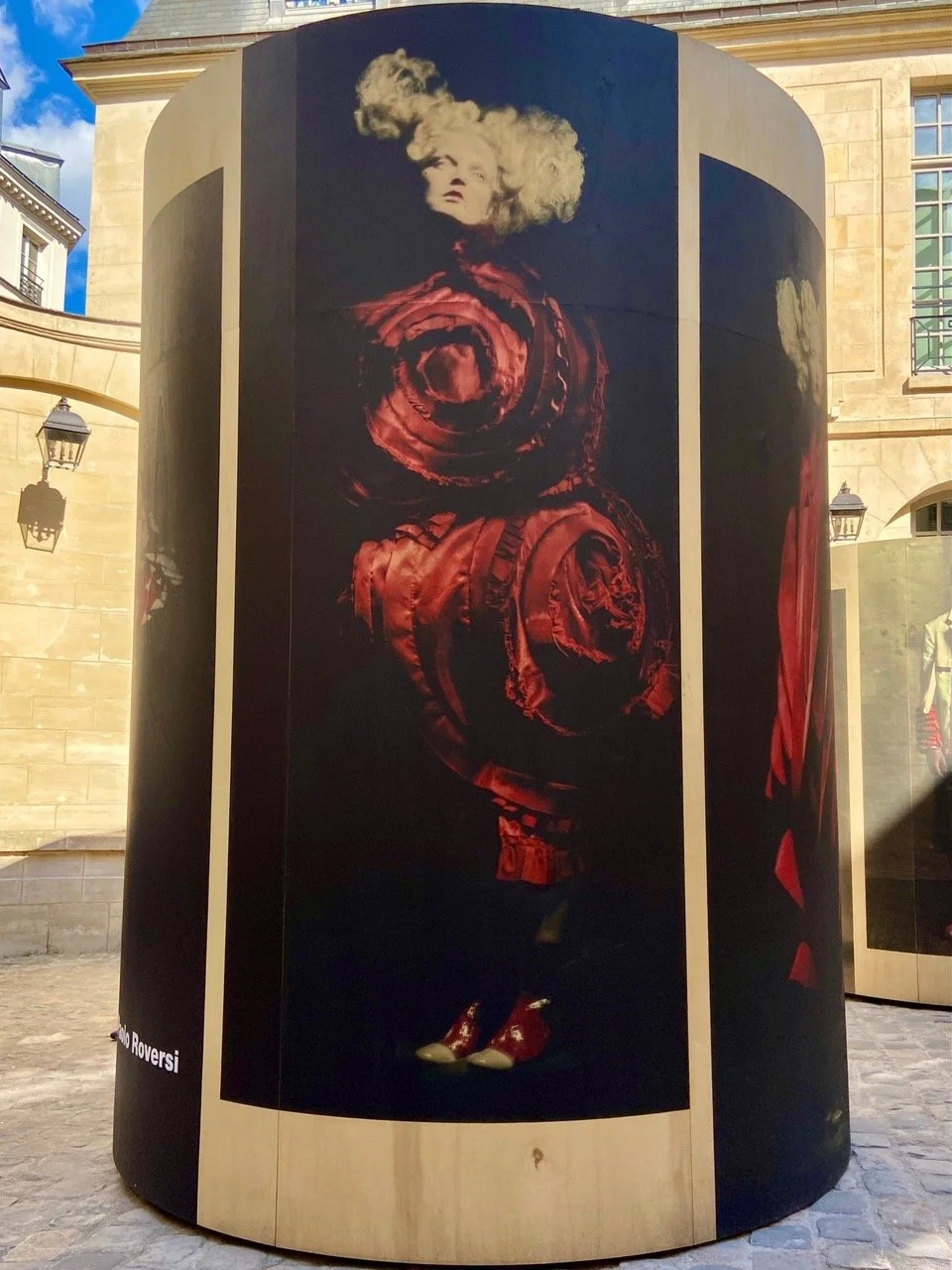Two fountains, Two exhibitions, Two free meals
Newsletter 06.23.2024
Bienvenue and welcome back to Musée Musings, your idiosyncratic guide to Paris and art. This weekend I finally had a chance to enjoy the beauty and bounty that is Paris. It was a weekend filled with flaneuring, which began a little early, on Thursday, after our monthly Mystery Book Club meeting at the American Library. This month’s book was Memory Game by Nicci French. Turns out, it’s a married couple who write together. The book was interesting but after our 2 hour discussion, we agreed that there were too many holes in the plot to pass our very demanding standards. But I enjoyed the writing so much that I picked up another book by the same authors. It was unreadably creepy. Thank goodness I checked out a Commisario Brunetti policier, to wash away the ghastliness of that other book.
Our book club has been having hybrid meetings since the pandemic. There were four of us at the library, so we decided to go to lunch. Because one of us was in a hurry, we plopped down at an empty table in an Italian restaurant where the waiter immediately slapped down four multi language menus on the table (never a good sign). I ordered a bruschetta, which came with a side salad. I was eating the salad (don’t ask me why) when my fork sunk into something that was definitely not lettuce. Upon investigation, I found a large brown clump. Well, for a salad, it was large. About the size of a thumb. It certainly should not have been there. When I showed it to the waiter, he brought over a plastic box filled with salad, insisting that what was in my plate must have come from that box. I wasn’t so sure. I stopped eating. The server asked if I wanted something else. I did not. I had eaten 1/2 of the bruschetta and lost all of my appetite. When the bill came, my bruschetta was not on it.
Maureen and I (she started the Mystery Book Club over a decade ago) decided to walk home along the Seine. En route, we checked out the new exhibition of street art at Fluctuart. (Fig 1) It was nice to see the exhibition and nicer still to catch up with Maureen, whose daughter Laura, a Franco-American lawyer, was so kind and helpful to me as I made my way through the labyrinth that is the French legal system.
Figure 1. An installation by Piotr Pauk (graffiti name, LUMP) at Fluctuart, Paris
On Friday, I was back at Au Pied du Cochon, with a friend who hadn’t been there in ages. We shared a small plate of oysters, which I have developed a taste for, finally. (Fig 2) When I was here with Nicolas, the woman next to us had a pot of moules. Not moules marinières as I had eaten at Bofinger, (Fig 3) but moules steamed with sausages, chorizo and ham. I had enjoyed a moules dish like that a few years ago at a bistro near Parc Monceau. And that’s what I wanted to eat.
Figure 2. Huitres at Pied du Cochon, Paris
Figure 3. Moules Marinières, Bofinger, Paris
When I took the lid off my pot of mussels, it was obviously moules marenières, not Moules Cochon Façon. I showed the waiter, he agreed, I showed the maitre d’hotel who also agreed. The waiter took away the moules. And returned in record time. I took off the lid and there were the same moules marenières but with chopped ham dumped on top. (Fig 4) I ate the moules but left the ham. Added as it was after the moules were steamed, it added no flavor. When I asked for the bill, I told the maitre d’hotel that I had not gotten the dish I ordered. He told me that was the way the moules were prepared at Au Pied du Cochon. I told him I knew that wasn’t so, since I had been there a few days earlier and the woman next to me had been served something completely different. Then he asked if I wanted to order something else. I did not. But I also didn’t want to pay for something I didn’t get. I was prepared to pay for the less expensive moules marenières. Instead, the moules were not on the bill.
Figure 4. Moules Marinières with ham dumped on top, Pied du Cochon
Two free meals in one weekend. Well, not really free since they both cost some unneeded stress. Complaining is never fun and it’s even less fun in a language not your own. But being dismissed as a tourist who accepts whatever they are served isn’t cool either. I did it for all of us. You’re welcome!
Okay, on to flaneuring. I have been visiting quaint streets in Paris, compiling a list that I will eventually share with you. The street I visited on Saturday was near still-a-building-site, Notre Dame. (BTW the informational placards around Notre Dame are worth taking time to read). But the street wasn’t as charming as it was supposed to be. As we were deciding what to do next, we stopped at Noir, a café on the Ile Saint Louis, just down the street from Berthillon. There are Noirs lightly scattered around Paris, but you will not mistake any of them for Starbucks. Each is different, but they all have the same minimalist, cool vibe - black and white with light wood surfaces. Depending upon the size of the space, there are banquets and chairs and outdoor seating (Noir Merci) Fig 5) or stools around small tables and sidewalk benches (Ile St. Louis). (Fig 6) They have coffee all the ways you expect and since they are also torréfacteurs, you can buy beans to go. They also have charcoal tea, matcha tea and golden tea. (Fig 7) I really liked the golden, which I make at home, using fresh turmeric root and fresh ginger root, freshly ground black pepper and a cinnamon stick. Their golden was creamy and delicious. I was surprised that the price of a beverage is less if you drink it in the cafe. That’s because it’s less wasteful to drink out of a washable cup than a disposable one. Kudos to them! There is a selection of patisseries - which I will have to try next time.
Figure 5. Merci Noir, Boulevard Beaumarchais
Figure 6. Noir, rue Saint Louis en l'Ile (Conde Nast)
Figure 7. Golden Tea, Noir, Ile Saint Louis (with liquid sugar that I did NOT use)
It was a warm and sunny day - of which there have been precious few in Paris for what seems like forever - so we strolled back across the bridge, having decided to see the exhibition on the restoration of the Fontaine des Innocentes at the Musée Carnavalet. But as we were walking past the lovely formal garden in which I sometimes sit, my friend remembered reading something about the building behind it. (Fig 8) Turns out, it's the Bibliothèque Forney, named after a 19th C Swiss businessman, who had a particular interest in art and crafts and a particular love for the city of Paris. He bequeathed money to the City for the creation of an institution promoting the education of artisans. After it outgrew its original location, the library was transferred to the Hôtel de Sens. (Fig 9) Which is a building that dates from the late 15th century. In the 16th century it was the residence of the archbishops of Sens. In the 17th century it became the property of the archdiocese of Paris. During the French Revolution it was confiscated and sold. During the 19th century, it was used, as so many hôtels particulier in the Marais were, for boutiques, workshops and factories. It gained heritage site status in 1862 and became the Bibliothèque Forney in 1929. But it was in such a sorry state of repair that the library could not move in until 1961.
Figure 8. Garden of Bibliothèque Forney (Hôtel de Sens) that I sit in or walk by several times a week
Figure 9. Hôtel de Sens (Bibliothèque Forney) entrance
It’s a lovely building and I was happy to finally see the inside of it. But even better was the temporary exhibition that is on until 28 September). Entitled, “Paris 1924 La Publicité dans la Ville” (Advertising in the City). (Fig 10) It has a lot in common with the huge exhibition currently on (to 13 October) at the Musée des Arts Décoratifs called La Naissance des Grands Magasins, 1852-1925.
Figure 10. Exhibition: Paris 1924 La Publicité dans la Ville, Bibliothèque Forney
The exhibition at the Forney is about advertising in Paris during les Années Folles, the Roaring Twenties. There are advertisements for boutiques and department stores, specific brands and particular products, cultural performances and sporting events. And institutional advertising, aka propaganda, too. The exhibition is a cacophony of posters on and in public transportation, on and in public buildings.
With the United States taking the lead, advertising became more professional, employing real artists to create posters and real writers to compose the text…Advertising came to embody the image of 1920s modernity. As the curators of the exhibition state, through “advertising, it is possible to understand the City of 1924, its current events, its appearance, its atmosphere, its department stores, its boutiques, its restaurants, its performance halls…” The place of sport is given special emphasis in this exhibition, conceived as it was with the Jeux Olympiques in mind. (Figs 11-20)
Figure 11. Advertisements plastered all over base of monument, Paris 1920s
Figure 12. Advertisements in newspaper at kiosks
Figure 13. Advertisement for Licorice
Figure 14. Advertisement for Dubonnet
Figure 15. Advertisement for an International Exhibition on Gas, Paris
Figure 16. ‘The Peace Loan’ Poster tells women that War is over, men have jobs and women have babies
Figure 17. Women Must Vote, a suffragette poster
Figure 18. Advertisement for tires
Figure 19. Advertisement for the Olympic Games, Paris 1924
Figure 20. People actually did swim in the Seine for the 1924 Olympic Games in Paris
On Sunday, I decided that I couldn’t wait any longer to try a croissant at the pop-up boulangerie on Boulevard Beaumarchais. It is the writing on the window that has intrigued me since I first saw it when Nicolas was here. The hand written note states that it takes 3 days to make the 300 croissants they sell each day. What the sign doesn’t say is that each croissant is 3€. Those are San Francisco prices, not Paris ones. The croissant was delicious - flaky and buttery. I don’t think it was twice as good as the croissants on sale at all the nearby boulangeries, that cost less than half that price. (Figs 21, 22) After the croissant, it was on to the marché, first to the crémerie for farm fresh eggs, a slice of Comte cheese (aged 24 months) and another of feta. And then to the primeur for white asparagus, orange apricots, red cherries and red tipped strawberries. At the fleuriste I got a small bunch of pink peonies that as they mature become lighter and lighter, inside and out. (Figs 23, 24, 25)
Figure 21. Pop Up boulangerie, Blvd Beaumarchais, They sell 300 croissants/day which take 3 days to prepare
Figure 22. Puffy and round and expensive (also quite delicious) Croissants
Figure 23. Peonies home from the marché
Figure 24. Same peonies 3 days later
Figure 25. Same peonies 5 days later
Just as I was leaving for the Musée Carnavalet to see the exhibition on the restoration of the Fontaine des Innocents, I had another idea. Shouldn’t I see the Fontaine in situ before learning about its restoration. So, that’s where I went instead. The Fontaine des Innocents is located on Place Joachim-du-Belly in Les Halles. It has gone through several iterations but the present one was more or less in place in 1548, during the reign of Henri II. (Figs 26-28) It was built to celebrate the king's entry into Paris after his coronation at Reims. Like the Hotel de Sens, it’s been on the list of historic monuments since 1862. And like the hotel, it fell into disrepair. The fountain’s current restoration should be completed this year (2024).
Figure 26. Fontaine des Innocents barricaded with one little window through I took this photo
Figure 27. Fontaine des Innocents. A peep above the barricade
Figure 28. Me outside the Musée Carnavalet with poster for exhibition that I WILL see
Just across from the Fontaine is a shallow but usually empty basin in which sculptures by Niki de Saint Phalle and Yves Tinguely rest inert. But not last Saturday, when the basin was filled and the sculptures were moving. It was fantastic, it was joyful! This is the fabulous Stravinsky Fountain, filled with 16 moving and spraying sculptures, that opened to the public in 1983. Jean Tinguely created the black mechanical sculptures, the brightly colored ones are by Niki de Saint Phalle, his wife.
The Stravinsky Fountain was part of the redevelopment project by the City of Paris for the area around Les Halles, the old city markets, which had been torn down in 1971. The 1982 commission for the fountain was originally Tinguely’s alone, but he convinced the City to let Niki de Saint Phalle work on the project with him. (Figs 29-32)
Figure 29. Stravinsky Fountain, sculpture by Niki de Saint Phalle
Figure 30. Stravinsky Fountain, Jean Tinguely sculpture
Figure 32. Stravinsky Fountain, sculptures by Niki de Saint Phalle & Jean Tinguely
Here is what Tinguely said about this fountain: "I wanted (it) to have charm, with the colors of Niki, the movement of the water, and a certain attachment of the heart that I gave to my sculptures. … I wanted sculptures like street performers, a little bit like a circus, which was at the heart of Stravinsky's style itself …when he wrote an homage to a circus elephant, …which he saw in a circus…”
And this, about the placement of the fountain,”…the…superb monstrosity, the Centre Pompidou … was an enormous provocation, and I couldn't put something monumental next to it...The only way to do it was to go to the opposite (direction) to think in terms … of speed, of movement, of charm, of games, of jokes, of competing with the street performers, the Afro-Cuban orchestras, the fire-eaters, who were in front of the Centre. That's why it had to have colors ....."
The fountain was a success from the beginning. The reporter for Le Monde (Mar, 1983) approvingly called it, “a Parisian fountain with the charm of an eighteenth century mechanical music box..”
And if that wasn’t enough for one day, as I walked home along rue Francs Bourgeois, toward the Place des Vosges, I looked into the courtyard of a building and saw huge prints of fashion photographs by Paolo Roversi. (Figs 33-37) about whose exhibition at the Palais Galleria I have written enthusiastically. Here photographs by Roversi are displayed on tall, curved wooden structures designed by Rei Kawakubo, the founder of Comme des Garçons. The photos are all Comme des Garcons fashions. Turns out, Kawakubo and her husband, Adrian Joffe, own this building. It’s the Dover Street Market Paris. The entire interior space of which, including the furniture in the Rose Bakery Café (a mini-chain with outposts at the Maison Balzac, Musée de la vie romantique and Bon Marché) was also designed by Kawakubo.
Figure 33. Dover Street Market Paris, courtyard, Paolo Roversi exhibition, Comme des Garçons clothes
Figure 34. Dover Street Market Paris, courtyard, Paolo Roversi exhibition, Comme des Garçons clothes
Figure 34a, Me inside looking at poster for exhibition
Figure 34b. Poster for Roversi exhibition at Dover Street Market Paris
Figure 34c. Roversi / Dover Street Market Paris poster chez moi (guess I could have pulled the drapes ….)
Figure 35. Dover Street Market Paris, Paolo Roversi exhibition, Comme des Garçons clothes
Figure 36. Dover Street Market Paris, Paolo Roversi exhibition,Comme des Garçons clothes
Figure 37. Dover Street Market Paris, Paolo Roversi exhibition,Comme des Garçons clothes
When Roversi was asked how he felt about having his work exhibited at the official opening of this boutique, he said that he has been collaborating with Kawakubo since the mid 1980s and that he has always been excited and stimulated by her work. “…I always want to go beyond (because) her work always goes beyond…People say my best work is for Comme des Garçons. Even at the Palais Galliera exhibition, there are many Comme des Garçons pictures. My story with the brand is very beautiful, very special, very strong.”
The building is a 17th-century hotel particulier, the Hôtel de Coulanges, where Madame de Sevigné (the favorite writer of Proust’s narrator’s grandmother) once lived. (Fig 38) Now it’s one of eight (the first in Paris) boutiques owned by Joffe and Kawakubo. The first of which opened in London, on Dover Street, 20 years ago.
Figure 38. Hôtel de Coulanges, Paris
The concept of their boutiques is to offer Comme des Garcons pieces along with those by other designers. A balance and a mix up according to Joffe, “of men’s and women’s, cheap and expensive. And something in the middle (by) more creative independent people.…” All in a space that will be constantly in flux, for an ever-changing roster of installations and pop-ups of art, photography, literature and food.
I only saw the Roversi exhibition but I’m looking forward to exploring the boutique next time I go.
That was my weekend. All places and spaces that I hope you’ll have a chance to visit the next time you are in Paris.
Thanks to everyone who took time to send a Comment about my adventures in Berlin, they are much, much appreciated. Gros bisous, Dr. B.
New comments on Ich bin immer noch ein Berliner! (I’m still a Berliner!):
From Kathy: Nicolas - Besides the current street art exhibition, when is the Petit Palais graffiti exhibit? Your art is exciting and Paris deserves to see it there, Washington, D.C.
From Dianne: Dear Beverly. I don't think Roosevelt hated de Gaulle but must have heard about him from Churchill who was trying to keep all the Allies going 'in the same direction'. From a biography of de Gaulle I understood that he was prickly and demanding but was about the only French official/officer who escaped to England able to rally the French to resist the Germans. He brought his wife and young child who had special needs on a plane offered by the English government in order to escape France. He is still so controversial after all these years. Interestingly, Jacques Pepin became his head chef for several years at a very early age. Imagine working for Gaulle in that capacity! Anyway, I always enjoy seeing what Nicolas is eating..a hearty appetite and good choices..
From Liz: Changing the subject there is a fab graffiti exhib on at the Petit Palais which I caught by accident on the first day...well recommended, Paris
From Randa: I absolutely love reading your posts. It feels like you are speaking directly to me as a good friend. Plus, I learn so much from you. You are so articulate! Thank you. RFalls Church, VA
From Ursula: Dear Dr. B: I enjoyed reading your take on Berlin, where I now live, after my 37 years of living in San Francisco. At first all of Berlin must seem very somber to a visitor. Yet I think its great that many of the sites and museums that are dealing with the our past are free to visit. There are though, I can assure you, many happy places to discover. Next time you are in Berlin it would be my pleasure to introduce you to them. Always love your stories about San Francisco even though they often make me 'homesick'. Greetings from Berlin
In Memoriam.
A final word about my old bank. A bank at which I would still be banking, if it hadn’t gone bankrupt. It was a bank, where if you had reason to call, anyone who answered the telephone would help you resolve your issue. If you found yourself at the bank, there were no tellers, there were no lines. There were people at desks, who would stop what they were doing as soon as you sat down. If you had to wait, and that was rare, there was a nice place to sit and have a cookie, always warm (don’t ask me how) and a cup of coffee or tea. It was a bank whose employees were as happy for their clients to be satisfied as they were to be making money for their employer. Long live the memory of First Republic Bank.
Copyright © 2024 Beverly Held, Ph.D. All rights reserved
Dear Reader, I hope you enjoyed reading this article. Please sign up below to receive more articles plus other original content from me, Dr. B. Merci!
And, if you enjoyed reading this review, please consider writing a comment. Thank you!

